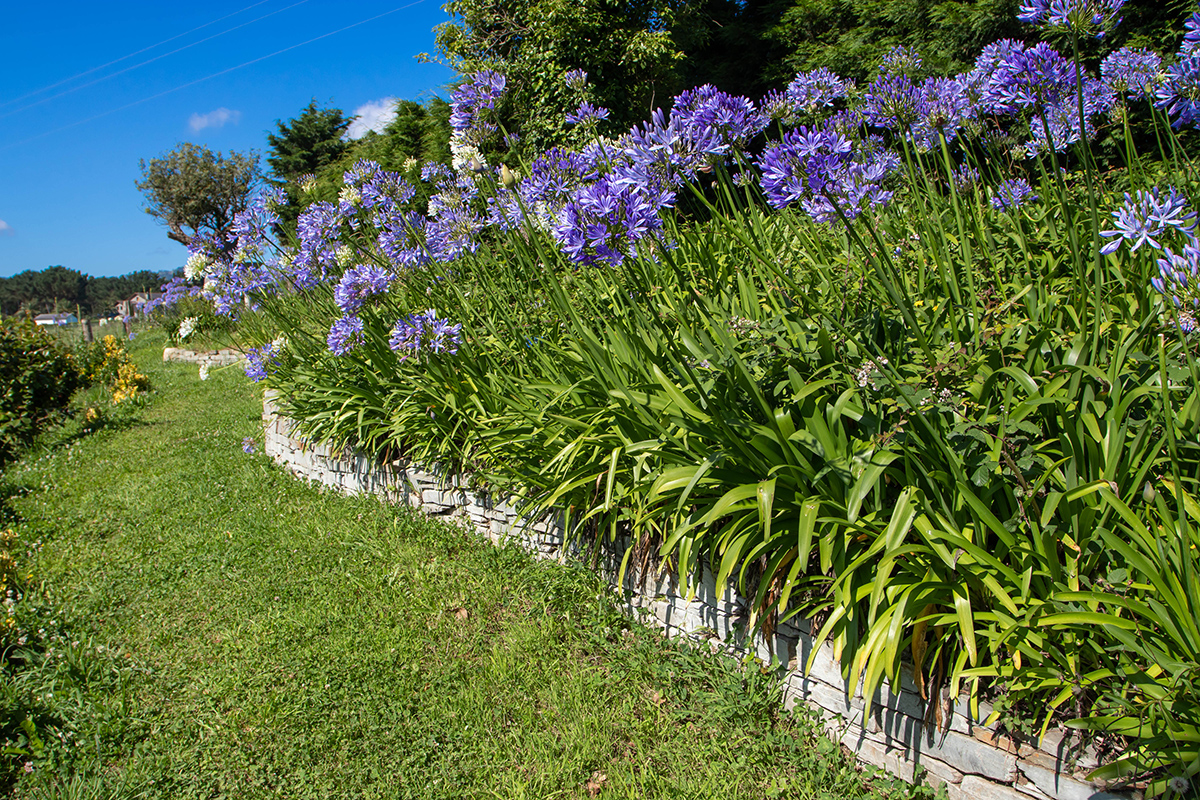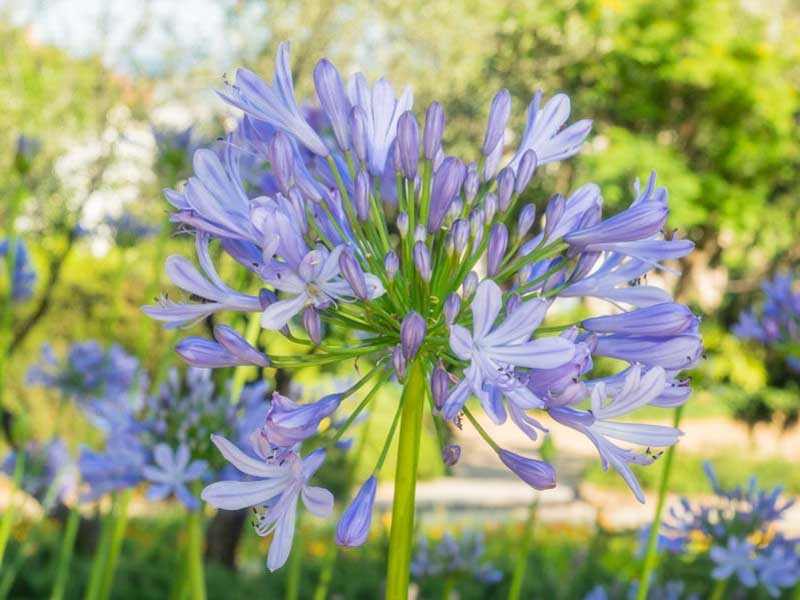Agapanthus Treatment Tips for Lush and Vibrant Flowers
Agapanthus Treatment Tips for Lush and Vibrant Flowers
Blog Article
Understanding the Art of Agapanthus Care: Necessary Steps for Healthy And Balanced Development and Dynamic Flowers
In the world of gardening, the farming of agapanthus stands as a fulfilling endeavor for those who seek to support these elegant flowering plants. From choosing the best variety to understanding pruning strategies, the trip in the direction of cultivating prospering agapanthus plants is complex and holds the key to opening the complete capacity of these organic treasures.

Choosing the Right Agapanthus Selection

When selecting the best Agapanthus selection for your garden, take into consideration aspects such as environment viability, flower shade, and development routine. Agapanthus, frequently known as Lily of the Nile or African lily, is available in a range of colors varying from tones of blue and purple to white. Pick a flower color that matches your existing garden palette to create a harmonious landscape. Furthermore, take into consideration the climate in your region to make certain the Agapanthus range you pick can flourish in your particular problems. Some varieties are extra tolerant of chilly temperatures, while others like warmer climates. Recognizing the growth behavior of various Agapanthus varieties is crucial for appropriate positioning within your garden. Some varieties have a clumping development behavior, perfect for containers or borders, while others have a more spreading nature, appropriate for ground cover or mass plantings. By very carefully reviewing these variables, you can pick the ideal Agapanthus variety to boost the appeal of your yard.
Suitable Growing Problems
Considering the ideal environmental demands is necessary for successful Agapanthus growing. Agapanthus flourishes in well-draining dirt with a slightly acidic to neutral pH level. When planting, pick an area that obtains complete sunlight to partial shade. In hotter environments, providing some mid-day color can stop scorching of the fallen leaves. Agapanthus plants are sensitive to chilly temperature levels and ought to be safeguarded from frost during cold weather.
To make certain healthy growth and vivid flowers, plant Agapanthus bulbs at a depth of regarding 2-4 inches and area them 8-12 inches apart. Adding raw material, such as garden compost, to the soil can enhance drain and fertility, advertising robust root growth. Mulching around the base of the plants aids keep dampness and suppresses weed growth. Routine watering is important, specifically during the growing season, to maintain the dirt continually moist yet not waterlogged.
Watering and Feeding Tips
Preserving correct dampness levels and supplying important nutrients are crucial elements in the treatment program for Agapanthus plants. It is essential to strike a balance when it comes to sprinkling Agapanthus. If overwatered, these plants like regularly moist soil yet are susceptible to root rot. During the expanding period, water deeply once a week, making sure the soil is well-draining to stop waterlogging. In hotter climates or throughout periods of drought, even more constant watering might be required to keep the dirt equally wet. Nonetheless, minimize watering in the wintertime to avoid water logged problems.
Fertilizing Agapanthus is necessary for promoting healthy and balanced growth and prolific flowers. Use a balanced plant food, such as a 10-10-10 formula, in the early spring as new development arises. Repeat this application every 6-8 weeks throughout the growing season. Prevent extreme fertilization, as it can cause look at this site rich vegetation at the cost of blooms. Constantly adhere to the producer's guidelines for appropriate dilution and application techniques. By complying with these watering and feeding suggestions, you can guarantee your Agapanthus plants flourish and produce vibrant, resilient flowers.
Pruning Methods for Agapanthus
Pruning Agapanthus plants at the suitable times and with appropriate methods is vital for keeping their wellness and promoting optimum growth and flowering. The ideal time to prune Agapanthus is in late winter months or very early spring prior to brand-new development arises.
Deadheading spent blossoms can additionally reroute the plant's energy into producing more flowers rather than establishing seeds. If you desire to collect seeds for breeding, leave some visit their website blossoms to completely dry and mature on the plant.
Keep in mind to use clean, sharp tools to make exact cuts and lower the danger of introducing conditions. Agapanthus. Normal pruning will aid keep your Agapanthus looking healthy and cool while making sure a bountiful display screen of lovely flowers
Taking Care Of Usual Bugs and Diseases
After making sure proper trimming techniques for Agapanthus, it is vital to address usual bugs and diseases that can influence the wellness and vigor of these plants. Agapanthus plants are typically sturdy however can still succumb certain issues. One common bug that influences Agapanthus is the Agapanthus gall midget. This little, orange fly lays its eggs in the foliage, causing distorted growth and flower buds that fail to open. To combat this insect, trim and ruin any kind of afflicted plant components and take into consideration utilizing insecticidal soap.
Another common problem is fungal leaf spot, which provides as dark sores on the fallen leaves. To protect against fungal conditions, guarantee excellent air circulation around the plants, prevent overhead watering, and get rid of any infected fallen leaves without delay. Additionally, Agapanthus plants can deal with origin rot if they are planted in poorly draining pipes dirt. To avoid this, plant Agapanthus in well-draining soil and prevent overwatering. By being cautious and taking timely activity against diseases and pests, you can assist your Agapanthus plants prosper and generate lively blooms.

Final Thought
Finally, understanding the art of agapanthus treatment entails picking the appropriate selection, offering ideal growing problems, correct watering and fertilizing, appropriate trimming methods, and resolving common bugs and illness. By following these important actions, you can make sure click to read healthy and balanced development and vivid blossoms for your agapanthus plants. Remember to frequently keep an eye on and preserve your plants to promote their general well-being and durability.
To ensure healthy growth and dynamic blossoms, plant Agapanthus bulbs at a depth of concerning 2-4 inches and area them 8-12 inches apart. By adhering to these watering and feeding pointers, you can ensure your Agapanthus plants prosper and produce vivid, lasting blossoms.
One typical pest that affects Agapanthus is the Agapanthus gall midge. Furthermore, Agapanthus plants can endure from origin rot if they are grown in inadequately draining soil. By adhering to these vital steps, you can make certain healthy and balanced development and dynamic blooms for your agapanthus plants.
Report this page